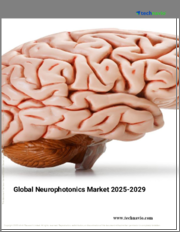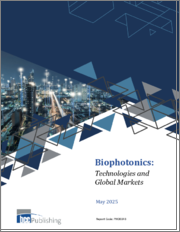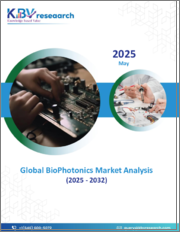
|
시장보고서
상품코드
1501711
세계의 바이오포토닉스 시장 규모 조사 : 최종사용자별, 용도별, 지역별 예측(2022-2032년)Global Biophotonics Market Size study, by End User by Application and Regional Forecasts 2022-2032 |
||||||
바이오포토닉스 세계 시장은 2023년 약 704억 달러로 평가되며, 예측(2024-2032년) 기간 동안 10.50% 이상의 건전한 성장률로 성장할 것으로 예상됩니다.
바이오포토닉스는 생물학적 요소를 보고, 감지하고, 조작하기 위해 빛을 생성하고 응용하는 연구입니다. 빛과 다른 방사 에너지원을 이용하여 생물의 내부 기관과 세포의 기능을 이해합니다. 생물학은 바이오포토닉스를 사용하여 분자의 구조, 기능, 과정을 연구합니다. 의학에서는 질병을 식별하고 치료하기 위해 미시적, 나노 및 거시적 생물학적 수준에서 빛과 조직의 상호 작용을 연구하고 있습니다. 또한 생체 물질, 세포, 조직, 동물 및 이분자 구조에서 방사선의 방출, 검출, 흡수, 변형 및 합성을 용이하게 합니다. 원격지나 자원이 제한된 환경에서도 사용할 수 있는 휴대용, 현장 진료용 바이오포토닉 장치에 대한 수요가 증가하고 있습니다. 기술적으로 진보된 바이오포토닉스 장비와 같은 주요 트렌드는 신속한 현장 진단 및 모니터링을 가능하게 하여 의료 서비스를 더욱 친숙하고 편리하게 만들어 줍니다. 따라서 이러한 추세는 2024-2032년 예측 기간 동안 세계 바이오포토닉스 시장의 성장을 더욱 촉진할 것입니다.
암, 심혈관 질환, 당뇨병과 같은 만성 질환의 발생률 증가는 바이오포토닉스 세계 시장의 중요한 촉진제입니다. 이러한 질병이 유행함에 따라 바이오포토닉스가 제공할 수 있는 첨단 진단 및 치료 기술에 대한 수요가 증가하고 있습니다. 바이오포토닉스 기술은 비침습적이고 정밀한 질병 조기 발견 및 모니터링 방법을 제공하여 효과적인 관리 및 치료에 필수적입니다. 예를 들어, 광간섭단층촬영(OCT)은 심혈관 조직의 상세한 영상화를 가능하게 하고, 형광 이미징은 암세포를 조기에 발견할 수 있도록 돕습니다. 또한, 바이오포토닉스는 환자 개개인의 프로파일에 맞는 정확한 진단 정보를 제공함으로써 개인 맞춤형 의료를 지원하고, 보다 정밀한 치료를 가능하게 합니다. 전 세계적으로 만성질환이 증가함에 따라 첨단 진단 도구와 효과적인 치료 옵션에 대한 수요가 증가하고 있으며, 이는 바이오포토닉스 시장 확대와 기술 혁신을 촉진하고 있습니다. 그러나 높은 장비 비용과 기술의 복잡성은 2024-2032년 예측 기간 동안 시장 성장을 저해하는 요인으로 작용하고 있습니다.
바이오포토닉스 세계 시장 조사에서 고려된 주요 지역은 아시아태평양, 북미, 유럽, 라틴아메리카 및 기타 지역이며, 2023년 북미는 매출 기준으로 가장 큰 지역 시장이었습니다. 북미 바이오포토닉스 시장은 기술 발전, 의료 수요 증가, 규제 환경의 지원에 힘입어 성장하고 있습니다. 이 지역은 생물 의학 연구와 혁신의 최전선에 있기 때문에 바이오포토닉스는 의료 문제를 해결하고 환자 결과를 개선하는 데 있어 점점 더 중요한 역할을 하게 될 것입니다. 비용 제약과 규제 준수와 같은 과제에도 불구하고, 개인 맞춤형 의료, AI 통합, 현장 진단의 지속적인 발전으로 인해 바이오포토닉스는 의료 서비스 혁신의 중요한 원동력으로 자리매김하고 있습니다. 또한 암, 심혈관 질환, 당뇨병과 같은 만성 질환의 발병률 증가는 첨단 진단 및 치료 솔루션에 대한 수요를 촉진하고 있습니다. 바이오포토닉스는 이러한 질환의 조기 발견, 모니터링 및 치료를 위한 정확하고 비침습적인 기술을 제공합니다. 또한, 아시아태평양의 시장은 예측 기간 동안 가장 빠른 속도로 발전할 것으로 예상됩니다.
목차
제1장 세계의 바이오포토닉스 시장 정의와 조사 가정
- 조사 목적
- 시장 정의
- 조사 가정
- 포함과 제외
- 제한사항
- 공급측 분석
- 입수 가능성
- 인프라
- 규제 환경
- 시장 경쟁
- 경제성(소비자의 관점)
- 수요측 분석
- 규제 프레임워크
- 기술의 진보
- 친환경
- 소비자 의식과 수용
- 조사 방법
- 조사 대상 연도
- 통화 환산율
제2장 주요 요약
- 바이오포토닉스 세계 시장 규모와 예측(2022-2032년)
- 지역별 개요
- 부문별 개요
- 최종사용자별
- 용도별
- 주요 동향
- 경기후퇴의 영향
- 애널리스트의 결론과 제안
제3장 바이오포토닉스 세계 시장 역학
- 시장 성장 촉진요인
- 시장 과제
- 시장 기회
제4장 바이오포토닉스 세계 시장 : 산업 분석
- Porter's Five Forces 모델
- 공급 기업의 교섭력
- 구매자의 교섭력
- 신규 참여업체의 위협
- 대체품의 위협
- 경쟁 기업 간의 경쟁 관계
- Porter's Five Forces 모델로의 미래지향적 접근법
- Porter's Five Forces의 영향 분석
- PESTEL 분석
- 정치
- 경제
- 사회
- 기술
- 환경
- 법률
- 주요 투자 기회
- 주요 성공 전략
- 파괴적 동향
- 업계 전문가의 관점
- 애널리스트의 결론과 제안
제5장 바이오포토닉스 세계 시장 규모와 예측 : 최종사용자별, 2022-2032년
- 의료 진단
- 의료 치료
- 검사·컴포넌트
- 비의료 용도
제6장 바이오포토닉스 세계 시장 규모와 예측 : 용도별, 2022-2032년
- 시스루 이미징
- 인사이드 이미징
- 분광 분자
- 표면 이미징
- 현미경 검사
- 광선요법
- 분석 센싱
- 바이오센서
제7장 바이오포토닉스 세계 시장 규모와 예측 : 지역별, 2022-2032년
- 북미의 바이오포토닉스 시장
- 미국의 바이오포토닉스 시장
- 캐나다의 바이오포토닉스 시장
- 유럽의 바이오포토닉스 시장
- 영국의 바이오포토닉스 시장
- 독일의 바이오포토닉스 시장
- 프랑스의 바이오포토닉스 시장
- 스페인의 바이오포토닉스 시장
- 이탈리아의 바이오포토닉스 시장
- 기타 유럽의 바이오포토닉스 시장
- 아시아태평양의 바이오포토닉스 시장
- 중국의 바이오포토닉스 시장
- 인도의 바이오포토닉스 시장
- 일본의 바이오포토닉스 시장
- 호주의 바이오포토닉스 시장
- 한국의 바이오포토닉스 시장
- 기타 아시아태평양의 바이오포토닉스 시장
- 라틴아메리카의 바이오포토닉스 시장
- 브라질의 바이오포토닉스 시장
- 멕시코의 바이오포토닉스 시장
- 기타 라틴아메리카의 바이오포토닉스 시장
- 중동 및 아프리카의 바이오포토닉스 시장
- 사우디아라비아의 바이오포토닉스 시장
- 남아프리카공화국의 바이오포토닉스 시장
- 기타 중동 및 아프리카의 바이오포토닉스 시장
제8장 경쟁 정보
- 주요 기업 SWOT 분석
- 주요 시장 전략
- 기업 개요
- Thermo Fisher Scientific Inc.
- 주요 정보
- 개요
- 재무(데이터 가용성에 따라 다름)
- 제품 개요
- 시장 전략
- Oxford Technologies
- Carl Zeiss AG
- Glenbrook Technologies Inc.
- Becton, Dickinson and Company
- Hamamatsu Photonics K.K.
- Lumenis Ltd.
- Olympus Corporation
- PerkinElmer Inc.
- Zenalux Biomedical Inc.
- Thermo Fisher Scientific Inc.
제9장 조사 과정
ksm 24.07.08Global Biophotonics Market is valued approximately USD 70.4 billion in 2023 and is anticipated to grow with a healthy growth rate of more than 10.50 % over the forecast period 2024-2032. Biophotonics is the study of producing and applying light to see, sense, and operate biological elements. It makes use of light and other radiant energy sources to comprehend how living things' interior organs and cell's function. Biology uses biophotonics to investigate the structures, functions, and processes of molecules. In order to identify, and cure diseases, light-tissue interactions at the micro, nano, and macro-organism levels are studied in medicine. Additionally, it facilitates the emission, detection, absorption, modification, and synthesis of radiation from biomaterials, cells, tissues, and animals as well as bimolecular structures. There is a growing demand for portable and point-of-care biophotonic devices that can be used in remote or resource-limited settings. The key trend such as technological advanced biophotonics devices enable rapid, on-site diagnostics and monitoring, making healthcare more accessible and convenient. Thus, this trend further supports growth of the Global Biophotonics Market during the forecast period 2024-2032.
The rising incidence of chronic diseases such as cancer, cardiovascular diseases, and diabetes is a significant driver for the Global Biophotonics Market. As these conditions become more prevalent, there is an increasing need for advanced diagnostic and therapeutic technologies that biophotonics can provide. Biophotonic techniques offer non-invasive, highly accurate methods for early disease detection and monitoring, crucial for effective management and treatment. For instance, optical coherence tomography (OCT) enables detailed imaging of cardiovascular tissues, while fluorescence imaging aids in identifying cancerous cells at early stages. Additionally, biophotonics supports personalized medicine by offering precise diagnostic information tailored to individual patient profiles, leading to better-targeted treatments. This growing demand for sophisticated diagnostic tools and effective treatment options, driven by the global burden of chronic diseases, propels the expansion and innovation within the Biophotonics Market. However, high cost of equipment and complexity of technology stifle market growth during the forecast period 2024-2032.
The key regions considered for the global Biophotonics market study includes Asia Pacific, North America, Europe, Latin America, and Rest of the World. In 2023, North America was the largest regional market in terms of revenue. The North American biophotonics market is driven by technological advancements, rising healthcare needs, and supportive regulatory environments. As the region remains at the forefront of biomedical research and innovation, biophotonics will play an increasingly vital role in addressing healthcare challenges and improving patient outcomes. Despite challenges such as cost constraints and regulatory compliance, ongoing developments in personalized medicine, AI integration, and point-of-care diagnostics position biophotonics as a key driver of innovation in healthcare delivery. Moreover, the rising incidence of chronic diseases, such as cancer, cardiovascular diseases, and diabetes, fuels the demand for advanced diagnostic and therapeutic solutions. Biophotonics offers precise, non-invasive techniques for early detection, monitoring, and treatment of these conditions. Furthermore, the market in Asia Pacific is expected to develop at the fastest rate over the forecast period.
Major market player included in this report are:
- Thermo Fisher Scientific Inc.
- Oxford Technologies
- Carl Zeiss AG
- Glenbrook Technologies Inc.
- Becton, Dickinson and Company
- Hamamatsu Photonics K.K.
- Lumenis Ltd.
- Olympus Corporation
- PerkinElmer Inc.
- Zenalux Biomedical Inc.
The detailed segments and sub-segment of the market are explained below:
By End User
- Medical Diagnostics
- Medical Therapeutic
- Tests & Components
- Nonmedical Application
By Application
- See-through Imaging
- Inside Imaging
- Spectro Molecular
- Surface Imaging
- Microscopy
- Light Therapy
- Analytical Sensing
- Biosensors
By Region:
- North America
- U.S.
- Canada
- Europe
- UK
- Germany
- France
- Spain
- Italy
- ROE
- Asia Pacific
- China
- India
- Japan
- Australia
- South Korea
- RoAPAC
- Latin America
- Brazil
- Mexico
- Middle East & Africa
- Saudi Arabia
- South Africa
- RoMEA
Years considered for the study are as follows:
- Historical year - 2022
- Base year - 2023
- Forecast period - 2024 to 2032
Key Takeaways:
- Market Estimates & Forecast for 10 years from 2022 to 2032.
- Annualized revenues and regional level analysis for each market segment.
- Detailed analysis of geographical landscape with Country level analysis of major regions.
- Competitive landscape with information on major players in the market.
- Analysis of key business strategies and recommendations on future market approach.
- Analysis of competitive structure of the market.
- Demand side and supply side analysis of the market.
Table of Contents
Chapter 1. Global Biophotonics Market Definition and Research Assumptions
- 1.1. Research Objective
- 1.2. Market Definition
- 1.3. Research Assumptions
- 1.3.1. Inclusion & Exclusion
- 1.3.2. Limitations
- 1.3.3. Supply Side Analysis
- 1.3.3.1. Availability
- 1.3.3.2. Infrastructure
- 1.3.3.3. Regulatory Environment
- 1.3.3.4. Market Competition
- 1.3.3.5. Economic Viability (Consumer's Perspective)
- 1.3.4. Demand Side Analysis
- 1.3.4.1. Regulatory frameworks
- 1.3.4.2. Technological Advancements
- 1.3.4.3. Environmental Considerations
- 1.3.4.4. Consumer Awareness & Acceptance
- 1.4. Estimation Methodology
- 1.5. Years Considered for the Study
- 1.6. Currency Conversion Rates
Chapter 2. Executive Summary
- 2.1. Global Biophotonics Market Size & Forecast (2022- 2032)
- 2.2. Regional Summary
- 2.3. Segmental Summary
- 2.3.1. By End User
- 2.3.2. By Application
- 2.4. Key Trends
- 2.5. Recession Impact
- 2.6. Analyst Recommendation & Conclusion
Chapter 3. Global Biophotonics Market Dynamics
- 3.1. Market Drivers
- 3.2. Market Challenges
- 3.3. Market Opportunities
Chapter 4. Global Biophotonics Market Industry Analysis
- 4.1. Porter's 5 Force Model
- 4.1.1. Bargaining Power of Suppliers
- 4.1.2. Bargaining Power of Buyers
- 4.1.3. Threat of New Entrants
- 4.1.4. Threat of Substitutes
- 4.1.5. Competitive Rivalry
- 4.1.6. Futuristic Approach to Porter's 5 Force Model
- 4.1.7. Porter's 5 Force Impact Analysis
- 4.2. PESTEL Analysis
- 4.2.1. Political
- 4.2.2. Economical
- 4.2.3. Social
- 4.2.4. Technological
- 4.2.5. Environmental
- 4.2.6. Legal
- 4.3. Top investment opportunity
- 4.4. Top winning strategies
- 4.5. Disruptive Trends
- 4.6. Industry Expert Perspective
- 4.7. Analyst Recommendation & Conclusion
Chapter 5. Global Biophotonics Market Size & Forecasts by End User 2022-2032
- 5.1. Medical Diagnostics
- 5.2. Medical Therapeutic
- 5.3. Tests & Components
- 5.4. Nonmedical Application
Chapter 6. Global Biophotonics Market Size & Forecasts by Application 2022-2032
- 6.1. See-through Imaging
- 6.2. Inside Imaging
- 6.3. Spectro Molecular
- 6.4. Surface Imaging
- 6.5. Microscopy
- 6.6. Light Therapy
- 6.7. Analytical Sensing
- 6.8. Biosensors
Chapter 7. Global Biophotonics Market Size & Forecasts by Region 2022-2032
- 7.1. North America Biophotonics Market
- 7.1.1. U.S. Biophotonics Market
- 7.1.1.1. End User breakdown size & forecasts, 2022-2032
- 7.1.1.2. Application breakdown size & forecasts, 2022-2032
- 7.1.2. Canada Biophotonics Market
- 7.1.1. U.S. Biophotonics Market
- 7.2. Europe Biophotonics Market
- 7.2.1. U.K. Biophotonics Market
- 7.2.2. Germany Biophotonics Market
- 7.2.3. France Biophotonics Market
- 7.2.4. Spain Biophotonics Market
- 7.2.5. Italy Biophotonics Market
- 7.2.6. Rest of Europe Biophotonics Market
- 7.3. Asia-Pacific Biophotonics Market
- 7.3.1. China Biophotonics Market
- 7.3.2. India Biophotonics Market
- 7.3.3. Japan Biophotonics Market
- 7.3.4. Australia Biophotonics Market
- 7.3.5. South Korea Biophotonics Market
- 7.3.6. Rest of Asia Pacific Biophotonics Market
- 7.4. Latin America Biophotonics Market
- 7.4.1. Brazil Biophotonics Market
- 7.4.2. Mexico Biophotonics Market
- 7.4.3. Rest of Latin America Biophotonics Market
- 7.5. Middle East & Africa Biophotonics Market
- 7.5.1. Saudi Arabia Biophotonics Market
- 7.5.2. South Africa Biophotonics Market
- 7.5.3. Rest of Middle East & Africa Biophotonics Market
Chapter 8. Competitive Intelligence
- 8.1. Key Company SWOT Analysis
- 8.2. Top Market Strategies
- 8.3. Company Profiles
- 8.3.1. Thermo Fisher Scientific Inc.
- 8.3.1.1. Key Information
- 8.3.1.2. Overview
- 8.3.1.3. Financial (Subject to Data Availability)
- 8.3.1.4. Product Summary
- 8.3.1.5. Market Strategies
- 8.3.2. Oxford Technologies
- 8.3.3. Carl Zeiss AG
- 8.3.4. Glenbrook Technologies Inc.
- 8.3.5. Becton, Dickinson and Company
- 8.3.6. Hamamatsu Photonics K.K.
- 8.3.7. Lumenis Ltd.
- 8.3.8. Olympus Corporation
- 8.3.9. PerkinElmer Inc.
- 8.3.10. Zenalux Biomedical Inc.
- 8.3.1. Thermo Fisher Scientific Inc.
Chapter 9. Research Process
- 9.1. Research Process
- 9.1.1. Data Mining
- 9.1.2. Analysis
- 9.1.3. Market Estimation
- 9.1.4. Validation
- 9.1.5. Publishing
- 9.2. Research Attributes

















